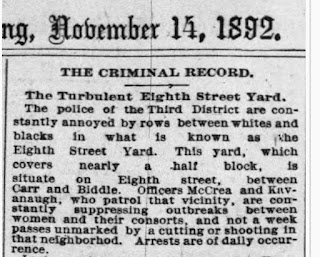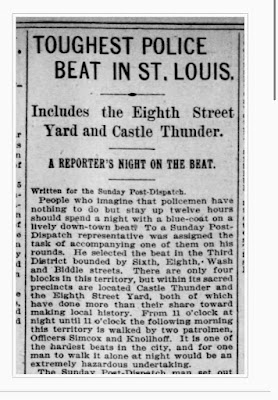St. Louis Globe Democrat, November 14, 1892
The police of the Third District are constantly annoyed by rows between whites and blacks in what is known as the Eighth Street Yard. This yard, which covers nearly a half block, is situate on Eighth street, between Carr and Biddle.
St Louis Post Dispatch, January 6, 1895
There are only four blocks in this territory, but within its sacred precincts are located Castle Thunder and the Eighth Street Yard, both of which have done more than their share toward making local history...It is one of the hardest beats in the city, and for one man to walk it alone at night would be an extremely hazardous undertaking.
Where exactly was the Eighth Street Yard? The first clipping above says it covered half a block on Eighth Street between Carr and Biddle. The clipping below provides an address.
St. Louis Globe-Democrat, March 6, 1893
1122 North Eighth. The tenement my 2nd great grandfather, Selig Feinstein, lived in, and owned, according to the 1900 census. The Eighth Street Yard appears a lot in the news between 1890-1895. Then it disappears.
When and how was the 8th Street Yard, one of the toughest police beats, cleaned up? When did Selig Feinstein purchase the address? What was his role? In the early 1890s he is listed in city directories as residing on Seventh Street, but working as a shoer/blacksmith at 1106 North Eighth. So he would naturally have had an incentive to move to the same block he worked. Once he owned the property, did he just kick out the rowdy residents and recruit new ones?
I hoped to get to the library this weekend to research deeds on microfilm, to pinpoint the exact year he purchased the property, and whether he purchased any other property in the area. There is some family lore that he may have. I do know that he went into the Real Estate business with his children starting in 1905, but he may have been a landlord of multiple properties before then. It doesn't look like I will get to the library this weekend due to weather and other factors. Maybe next weekend.











1 comment:
Fascinating. It's interesting for the time period that there was no knee-jerk blaming of the blacks (which probably indicates it was white violence against blacks.) Am also interested also in the terminology, that the article says "black" instead of negro or colored. Am not sure what would have been considered the "polite" or "correct" term at the time.
Post a Comment